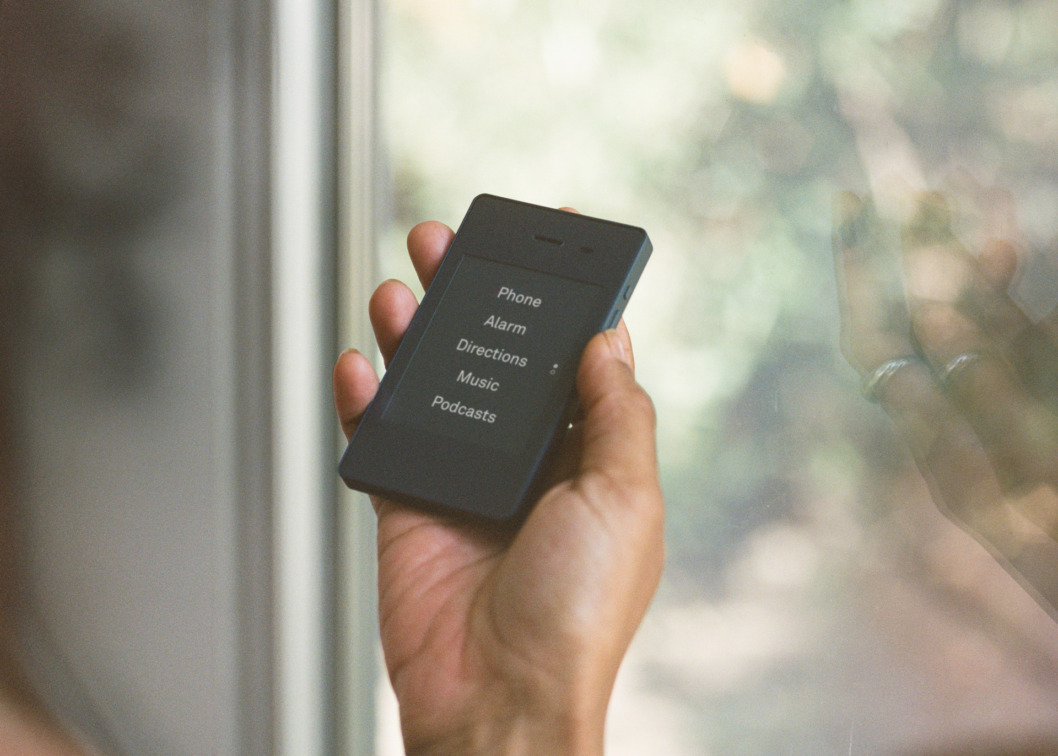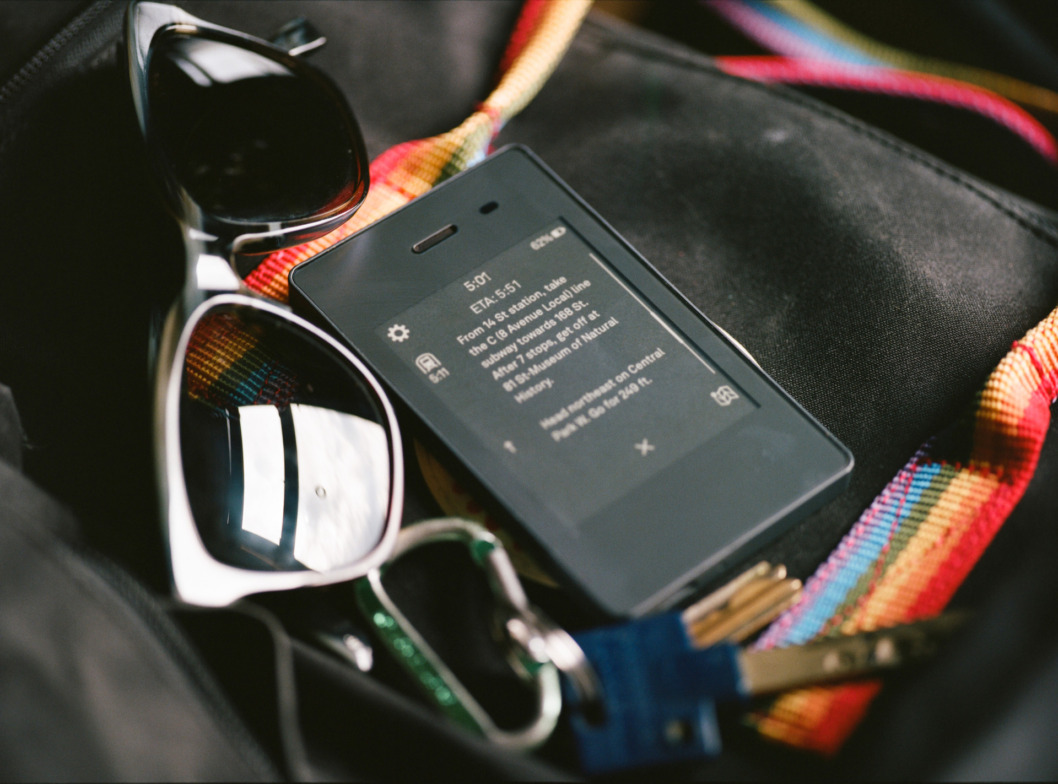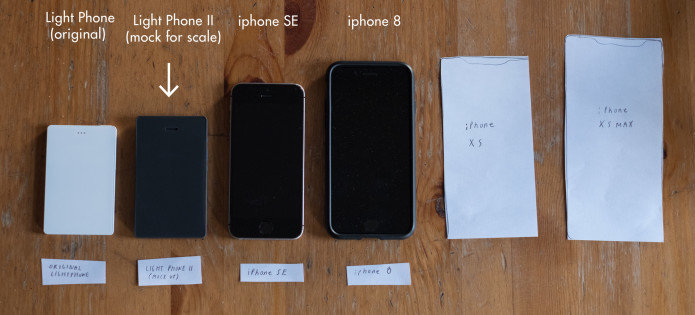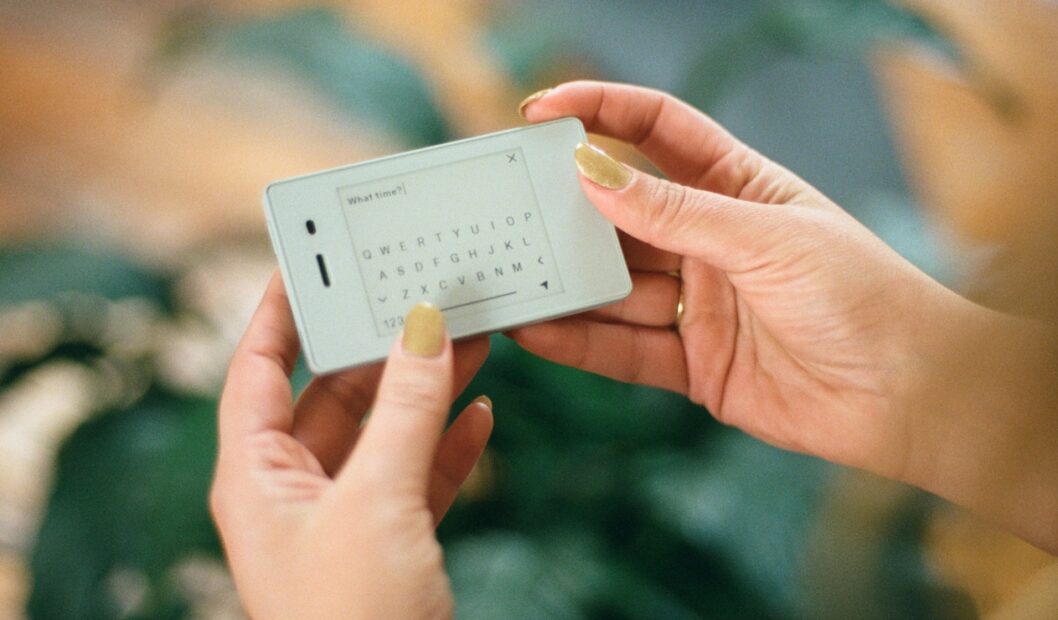In the course of prepping this interview for you to read, I probably checked my phone five or six times. I’m not the only one: half of Americans spend five to six hours on their phone every day excluding work-related tasks. It’s a serious social problem, and the folks at Light Phone are working on a solution.
Light Phone is designed to be used as little as possible. It’s a simple idea: take all the good parts about a smartphone – phone calls and texts, the calculator, music and podcasts, alarms, and directions. Then strip away all the stuff that steals your attention. No social media, no browsing, no email, news, or ads. Everything that is and is not on Light Phone is deliberate.
It’s even designed to look and feel like a tool and not a toy. Instead of using a distracting and bright display, Light Phone uses sedate E-Ink for a display that’s easy the read at night and in broad daylight. Plus the battery lasts a long time, meaning you don’t even have to constantly think about charging it.
In this interview, we ask Co-Founder and CEO Kaiwei Tang to tell us about how he came up with the idea, how he turned it into a real product, and how he got people on board with the idea of a distraction-free phone.
What follows is a transcript of our conversation. It has been edited for clarity and brevity.

First, tell us a little bit about Light Phone.
Light Phone is a phone that is designed to be used as little as possible.
It doesn’t fight for the important things that we take for granted, our time and attention. The Light Phone offers utility and the peace of mind we’ve become accustomed to with our smartphones whilst eliminating the distractions, manipulation and stress of social media, news, or email. I don’t believe that the ever-increasing digital connection makes us happier.
It’s also a simple phone that is built around intention and purpose. It’s not a dumbphone. It offers modern tools such as calls, texts, directions, music, podcasts, hotspot, etc. through a completely customized and in-house designed typographic-based interface.
We spent years designing and developing Light Phone to produce a slim, credit card-sized phone with a matte black and white E-ink screen. The screen feels nothing like a smartphone, which is not an accident and it is perfect for viewing outdoors in direct sunlight. It’s a phone that isn’t interested in collecting and selling your data, ever.
We call it a phone for humans.
How did you first come up with the idea of the Light Phone?
My co-founder Joe Hollier and I were invited to a designer incubator hosted by Google in 2014. We were encouraged to build a mobile application, but we quickly realized that making another app is just the last thing this society needed from us. People are becoming increasingly frustrated and appalled at how much time their phones were sucking out of their lives and we wanted to create something that would give those people an alternative.
Almost every tech company were and still are, making apps that are “sticky” — they encourage users to stay for long periods of time. The reason is simple, the longer someone uses an app, the more revenue an app could make through advertising; however, the result is devastating to our attention and well-being.
As a reaction to the pernicious influence of time-grabbing apps & social media, we decided to create a product that would encourage users to take a break from the internet and their smartphone.

How did people initially react when you pitched the idea of creating a new smartphone?
The reactions were extremely polarized in 2014. People either loved it thinking that its radical approach could change their life for the better, or they could not see a reason to lower their screen time. Everyone had a strong opinion on the Light Phone, which continues to this day.
Our users often told us that having a Light Phone in public sparked some really great conversations between them and other people. They chatted about why they chose to “Go Light”, they discussed their relationship with technology, what problems they have experienced with social media and apps as well as what phone features are critical to them.
I think it’s really amazing that the Light Phone becomes a conversation piece and our users are making a conscious choice. Part of what we are trying to do is to be more intentional in terms of deciding what technology to use and how we design our tech tools.
How long did it take you to develop Light Phone II?
It took us almost 2 years from designing, developing to actually shipping Light Phone II. We customized almost every aspect of the phone to make sure the design aligns with our mission and the value of the company. It wasn’t a re-purpose of any existing phone on the market. It was a challenge for both us and our suppliers at the time, to work on such highly customized hardware and software. It is part of the reason the price of an unlocked LPII ($299) might seem relatively high if you compare it to any vintage feature phones or flip phones.
Customized hardware requires a lot MOQ (minimum order quantity) on almost every component inside the phone. We are not a big technology company like Apple or Samsung, we can’t afford to order any part in hundreds of thousands to get lower costs. This is something we have been trying to be transparent about and communicate with our customers as well. It is the reality of a small start-up but hopefully as we continue to grow we can offer a more affordable option.

What was the first prototype like?
The first prototype of Light Phone II is a 3D printed solid block I did in our co-working space. We were trying to get a look and feel on different sizes and thicknesses. It’s a non-functional mock. I also bought many used vintage phones, broke them apart, and then reassembled them to create the first functional light phone from those scrapped components. It was like a scene out of Todd McLellan’s book, Things Come Apart.
Did you have to create your own e-Reader ink?
We worked with our manufacturing partner, E-ink Technology, to create a smaller size e-ink display that wasn’t available on the market. We also spent a year optimizing the performance and refresh rate of the display. E-ink displays are not often used on phones so there was lots of trial and error to get to where we are.
How did you secure funding?
Light Phone II IndieGoGo campaign in 2018 really kicked us off. We raised over $3.5 million via pre-orders from our wonderful backers who believe in us. The campaign also led to a good deal of press coverage here in the US and internationally. The media attention gave us and our prospective investors a really good indication of whether or not people want the product.
The last several years we received investment from mission-aligned angel investors and VCs such as Pinterest’s Ex-President Tim Kendall, Lyft Co-Founder John Zimmer, Twitter’s Co-Founder Biz Stone, Bullish VC, Able Partners, Hinge VC, White Bay Group, and many others.
We are really grateful for the support from our early backers and investors.
How were you able to market a product specifically made to avoid social media and similar distractions?
I honestly don’t think paid social media advertisement is or should be the only way to promote a product. It has definitely proven to be effective on many products but at the same time, social media and the majority of technology companies are basically profiting from our data, attention and time.
The last few years we have had a lot of customers help us spread the word to their friends and family based on their experience using Light Phones. We also received lots of press coverage organically.
I think a user’s endorsement is so powerful and it also makes the product really meaningful to others. Instead of spending millions on paid marketing, I think we prefer to spend our limited resources on making the experience better. That being said, hopefully more people can find out about Light Phone and join all our users “going Light.”

What was the mass manufacturing process like, especially with all the supply chain disruptions?
Recent supply chain disruptions did slow us down. We have many vendors that provide components of the phone and their factories are located in different regions of the world. Other than the shipping backlog that I think a lot of people heard about and were affected by, we have also had to contend with COVID lockdowns in local areas that disrupted our vendor’s shipment and schedule.
We tried our best to keep people posted about shipping irregularities and be transparent about the problems our suppliers had. Thankfully our customers are very understanding and trust we are doing all we can.
How do Light Phone users get cell service? Which networks are covered and how do they pay for the plan?
We have our own Light SIM card and service plan (optional). Our users can use the Light plan which is on AT&T network, or use their existing T-Mobile, Verizon, or AT&T SIM card.
Light dashboard is where Light Phone II users customize their phones, accounts, tools as well as payment.
Do you find yourself marketing more to smartphone users? Or traditional phone users who might want a little bit extra?
I do think all users have different needs and different senses of what makes an ‘essential tool’, which is why we are working on adding a few more utility tools so that more people feel comfortable to Go Light. Although, Light Phone will never have social media, browser or advertisements.
The last few years we have been focused on sharing the health benefits of going light that we have heard from our users i.e. less stress, less anxiety, becoming more productive, getting more time back, sleeping better, etc. We also have parents and schools who are interested in getting a Light Phone as their kid’s first phone.
We also created a campaign to interview our users so they can share their experiences firsthand.
Going Light with Desi from The Light Phone on Vimeo.
Are there any exciting future upgrades on the horizon?
At the moment, we offer phone, text, direction, music, podcast, hotspot, calculator, and an alarm clock on Light Phone II. We have plans to introduce other utility tools such as a calendar, meeting reminders, notepad, barcode reader, voice memo, two-factor authentication… We are also working on a feature that would enable users to use their existing smartphone number on Light Phone II.
Interested in ordering a Light Phone for yourself or a friend? Check out their website here to learn more.

